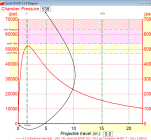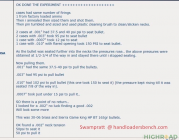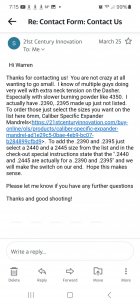I'm using lapua brass and I forget the reamer specs, but it's not a tight neck. I'm not really interested in neck turning. At least not in this stage of my life.Outside neck turning would seem to be #1, on the to do list. Goes with full benchrest prep of the brass.
Then, deal with springback.
I dont use mandrels.
You are using an out of date browser. It may not display this or other websites correctly.
You should upgrade or use an alternative browser.
You should upgrade or use an alternative browser.
Adjusting neck tension when using mandrels
- Thread starter goosepilot
- Start date
Thanks.Mandel is an option but not a necessity, spring back imo is a non factor, turned necks or no turn neck, many LR guys just measure the neck OD of a loaded round and subtract .002 -.005 and order those four bushing and test each one side by side and let the target show you the path forward.
Personally I like a tapered Wilson bushing.
Jim
So which way do you insert bushing? Numbers down?
He sold the dies before I bought the rifle. The rifle only had 50 some rounds through it, but was the 3rd one from the gunsmith. I now have a wilson bushing sizer and micrometer seater. Just a matter of a little experimenting in the next weekMaybe talk to the guy you bought it from and see what he used, he might sell his dies and just maybe give his load data
The idea behind the mandrel is to make the brass concentric for bullet seating. Any irregularities go to the outside. By turning necks, you have a concentric neck wall thickness to do anything you want to, with any bushing or mandrel combination you can come up with. Imo, you are leaving a lot on the table by not turning the necks concentric before you do all the experimenting. Just my take on it. Good shooting to you.I'm using lapua brass and I forget the reamer specs, but it's not a tight neck. I'm not really interested in neck turning. At least not in this stage of my life.
Paul
AlNyhus
Silver $$ Contributor
Same as the SR competitors, Jim.Mandel is an option but not a necessity, spring back imo is a non factor, turned necks or no turn neck, many LR guys just measure the neck OD of a loaded round and subtract .002 -.005 and order those four bushing and test each one side by side and let the target show you the path forward.
Personally I like a tapered Wilson bushing.
Jim
AlNyhus
Silver $$ Contributor
Absolutely correct, Paul.The idea behind the mandrel is to make the brass concentric for bullet seating. Any irregularities go to the outside. By turning necks, you have a concentric neck wall thickness to do anything you want to, with any bushing or mandrel combination you can come up with. Imo, you are leaving a lot on the table by not turning the necks concentric before you do all the experimenting. Just my take on it. Good shooting to you.
Paul
If necks are so eccentric that using a mandrel is needed to address bullet concentricty, the necks need to be touched up by a light turning. Often, just enough to remove the eccentric...around 75% of the outside neck...is all that's needed to be done.
Good shootin'
MikeRu
Gold $$ Contributor
21st century will make mandrels down to 238 or so. I bushing down to about 237-238 then mandrel up with 240-242 to get whatever seating pressure that works best , using Wilson seater, K&M arbor press and guage.So I'm relatively inexperienced reloader. Early on using redding bushing sizes, I got tapered necks. Ran across the sinclair expanding mandrel and have been using it for 5 ish years.
Now I just got into 600-1k yard bench shooting and bought a 6mm dasher from a guy retiring from shooting. So I thought I would test neck tension adjustments, but no one seems to make any mandrels less than .240. Depending on brass, I'm getting. 015-.025 neck tension.
Cortina's company responded to my email saying to adjust bushing size. To it seems like I should adjust mandrel size. I do use amp annealer each firing. I ordered more smaller sizes of bushings but they haven't arrived yet.
Was just curious what others who use expander mandrels do to adjust neck tension?
DLT
Silver $$ Contributor
Never did on any of my brass. 223 and 22/250Hey guys, I thought the mandrel also helped push doughnuts back out?
ELR LVR
Silver $$ Contributor
I would not think you would get more neck tension eitherI borrowed 262, 263 and 264 wilson bushings today to load for a seating depth test. I did not get more neck tension by using a smaller bushing prior to expander.
I ran an experiment last night to proof my theory on this
Posted here:
Does the bullet slide out of the neck or does the neck open to release it?
Primer fires, some powder burns, making gas. The gas pushes the remaining 2/3 powder forward, against the bullets base. It continues to burn till it consumed. Burn rate makes a difference. Slow powders may exit the muzzle, unburnt. https://discover.dtic.mil/
forum.accurateshooter.com
I would not think you would get more neck tension either
I ran an experiment last night to proof my theory on this
Posted here:
Does the bullet slide out of the neck or does the neck open to release it?
Primer fires, some powder burns, making gas. The gas pushes the remaining 2/3 powder forward, against the bullets base. It continues to burn till it consumed. Burn rate makes a difference. Slow powders may exit the muzzle, unburnt. https://discover.dtic.mil/forum.accurateshooter.com
I read your post which you linked to, you've done your homework
I'll throw in another angle which crossed my mind. Measuring the I.D. of necks compressed by different diameter bushings, after seating and bullet pulling, as a proxy for neck tension tells one story. The other story, possibly, is we don't know how much effort it took to pull the bullets. Is it possible for the pulled necks to revert to the same I.D. even if they exert different radial forces on the bullet, i.e. have different neck tensions? I think it's possible depending on where the necks are on the elasticity curve.
None of it probably matters on the target, just fun stuff to ruminate. I made a bullet pulling force gage a ways back, I'll dust it off and see if there's any low hanging fruit.
Coyotefurharvester
Silver $$ Contributor
I do most of my brass prep per #2. Mostly hunting, prairie dog loading. Both gas and bolt guns. Mandrels I use (regardless of caliber/cartridge) are 0.002- 0.003 under bullet dia. I use bushings that size the brass down so the mandrel expands the neck 0.002-0.003. Does not seem to work the brass hard and is enough to ensure neck is round(gas guns are hard on necks). My 20p(gas gun) does require a slight crimp, even with mandrel more than 0.002 under bullet diameter, or the bullet coal shortens a few thou after loading of the mag a couple times in cold weather.
Edd
Gold $$ Contributor
I would buy a pin gauge and make my own.So I'm relatively inexperienced reloader. Early on using redding bushing sizes, I got tapered necks. Ran across the sinclair expanding mandrel and have been using it for 5 ish years.
Now I just got into 600-1k yard bench shooting and bought a 6mm dasher from a guy retiring from shooting. So I thought I would test neck tension adjustments, but no one seems to make any mandrels less than .240. Depending on brass, I'm getting. 015-.025 neck tension.
Cortina's company responded to my email saying to adjust bushing size. To it seems like I should adjust mandrel size. I do use amp annealer each firing. I ordered more smaller sizes of bushings but they haven't arrived yet.
Was just curious what others who use expander mandrels do to adjust neck tension?
ELR LVR
Silver $$ Contributor
What I am suggesting is there is no further radial forces by neck sizing down furtherI read your post which you linked to, you've done your homework.
I'll throw in another angle which crossed my mind. Measuring the I.D. of necks compressed by different diameter bushings, after seating and bullet pulling, as a proxy for neck tension tells one story. The other story, possibly, is we don't know how much effort it took to pull the bullets. Is it possible for the pulled necks to revert to the same I.D. even if they exert different radial forces on the bullet, i.e. have different neck tensions? I think it's possible depending on where the necks are on the elasticity curve.
None of it probably matters on the target, just fun stuff to ruminate. I made a bullet pulling force gage a ways back, I'll dust it off and see if there's any low hanging fruit.
After being stretched out the same amount
---Unless the brass is thicker
To quote WIld Bill IV who explained further after my post
"Cartridge brass can be compressed 0.0005" and will recoil back that 0.0005" without being reformed or reshaped!!! Upon reshaping (reforming) the brass, the grains and boundaries of the grains under high stresses and strains!! "
Quote from post 100
Does the bullet slide out of the neck or does the neck open to release it?
Primer fires, some powder burns, making gas. The gas pushes the remaining 2/3 powder forward, against the bullets base. It continues to burn till it consumed. Burn rate makes a difference. Slow powders may exit the muzzle, unburnt. https://discover.dtic.mil/
forum.accurateshooter.com
The reforming --- changes the grains and boundaries to reform a new shape
it no longer will retain it's old shape
The new shape is your bullet diameter
----------------------------------------------------
I'd be interested to see your findings with your pulling force gauge
necks with .009"-.012" neck thickness
then with necks thicker than .012"
---------------------------------------------
I'd be willing to suggest that once at .015 such as winmag brass, things change and there would be more spring back with smaller neck sized brass
---------------------------------------------
if you have any coated bullets, I'd try those too
Last edited:
What I used the pull gage for at the time was to accurately determine peak force needed to pull a bullet in order to compare that to the peak force required to seat the bullet; pulling force was about 2/3 the seating seating force. Knowing the cross-sectional area of the bullet, it was easy enough to calculate the pressure require inside the case to pop the bullet out. When compared to the maximum pressure for 6.5 Creedmoor, 63000-ish psi, it was negligible and not readily identifiable on a QuickLoad pressure graph where projectile travel is shown on the X-axis. IIRC, it would take about 550 psi to pop a bullet from the cartridge.
This led me to believe that while there are many good reasons to have neck tension, such as ensuring cartridges stay intact bouncing around in a box, or getting banged around in a magazine etc., and keeping the bullet pointed coaxially to the throat and rifling, I have my doubts that it has much effect on building the pressure curve.

This led me to believe that while there are many good reasons to have neck tension, such as ensuring cartridges stay intact bouncing around in a box, or getting banged around in a magazine etc., and keeping the bullet pointed coaxially to the throat and rifling, I have my doubts that it has much effect on building the pressure curve.

ELR LVR
Silver $$ Contributor
Precisely, and my thoughts as well.This led me to believe that while there are many good reasons to have neck tension, such as ensuring cartridges stay intact bouncing around in a box, or getting banged around in a magazine etc., and keeping the bullet pointed coaxially to the throat and rifling, I have my doubts that it has much effect on building the pressure curve.
View attachment 1647266
I just posted in another thread...it's more of a placebo effect
Thank you for your insight
Last edited:
ELR LVR
Silver $$ Contributor
Another member here ( 46and2) did an experiment as I did
But also measured the pull force required to pull the bullets after seating
His results were that ...
it took the same amount of force to pull a bullet as it did to seat it
--------------------------
posted in Post 79 here:

But also measured the pull force required to pull the bullets after seating
His results were that ...
it took the same amount of force to pull a bullet as it did to seat it
--------------------------
posted in Post 79 here:
Does the bullet slide out of the neck or does the neck open to release it?
I never, or possibly very rarely, ever see the complete absence of blow by before bullet exit. I do assume the bullet seals the barrel, and a video where gas is escaping AS the bullets exits would point to some serious inaccuracy questions. If we view a cartridge and its neck as little...
forum.accurateshooter.com

Last edited:
ELR LVR
Silver $$ Contributor
Are the 2 differences we're looking atTwo different bushings only a .001” apart
2x fired brass, seems like a big difference
Haven’t tested it yet on paper View attachment 1647289
Bullet Seating force
or
Bullet Pulling force
Because, seating force could be triple, of the force needed to cause the bullet to exit and does not necessarily correlate with one another
---------------------
As I've mentioned seating force to insert a bullet into a smaller orifice stands to reason will be higher
but once inside the neck, there should not be much difference to pull the bullet out of each case
----------------------
I am open to correction if someone finds different results but look a couple posts above as another guy did that test which I posted his results
---------------------------
Maybe what I'll try later is
take a .224 case and size it down to .17
take a second and size it down to .221
then test the differences of force required to PULL the bullet
Seating force is not relative here to what we're trying to test or accomplish
--------------------------
Only pulling force to get the bullet out is
Similar threads
- Replies
- 6
- Views
- 267
- Replies
- 29
- Views
- 1,874
Upgrades & Donations
This Forum's expenses are primarily paid by member contributions. You can upgrade your Forum membership in seconds. Gold and Silver members get unlimited FREE classifieds for one year. Gold members can upload custom avatars.

Click Upgrade Membership Button ABOVE to get Gold or Silver Status.
You can also donate any amount, large or small, with the button below. Include your Forum Name in the PayPal Notes field.
To DONATE by CHECK, or make a recurring donation, CLICK HERE to learn how.

Click Upgrade Membership Button ABOVE to get Gold or Silver Status.
You can also donate any amount, large or small, with the button below. Include your Forum Name in the PayPal Notes field.
To DONATE by CHECK, or make a recurring donation, CLICK HERE to learn how.











